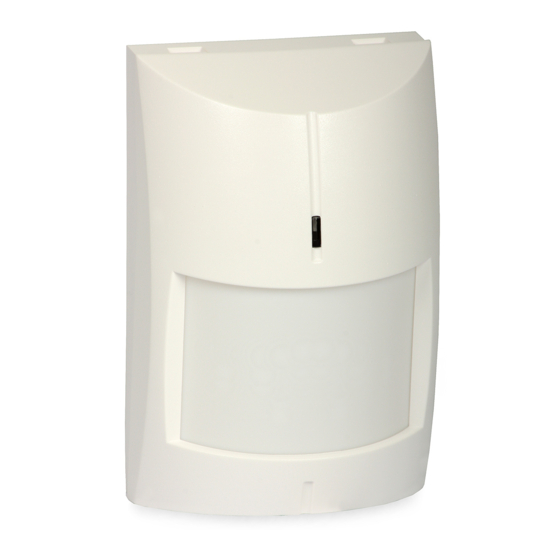Advertisement
Quick Links
®
GRAPHITE
DIGITAL PASSIVE INFRARED DETECTOR
The GRAPHITE digital motion detector is characterized by high sensitivity, as well
as high immunity to interference and false alarms. The detector construction is
based on an advanced signal processor with a high resolution transducer. A dual
pyroelectric element is used in the detector. An advanced digital temperature
compensation feature enables operation within a wide range of temperatures.
Other advantages of the detector include alarm memory and remote on/off
switching of the LED indicator.
NC
NC
TMP
1
2
4
7
8
Figure 1. View of the detector electronics board.
Explanations for Figure 1:
1 – terminals:
NC
– relay (NC).
TMP – tamper contact.
COM – common ground.
12V
– power supply input.
LED – the input enables the LED indicator to be remotely switched
ON/OFF, if the jumper is removed from the LED ON/OFF pins. The
LED will signal violations, when the LED input is short-circuited to
the common ground. For control of the input, you can use the OC
type output of the control panel, programmed e.g. as S
or BI
MODE INDICATOR
MEM – the alarm memory control input. It is required that the OC type
output of the alarm control panel, programmed as A
be connected to the input. When the input is shorted to
INDICATOR
the ground and the detector registers a motion, thus triggering the
alarm, the LED blinking will signal the alarm memory. The alarm
memory signaling will continue until the input is shorted to the
ground again. Cut-off of the input from the ground (disarming) will
not erase of the alarm memory.
2 – LED indicator. It lights red for approx. 2 seconds after registration of
movement by the detector and activation of the relay (opening of the NC
contacts). It allows the installer to check the detector performance and to
approximately determine the supervised area. Blinking of the LED indicates
alarm memory.
3 – LED ON/OFF pins. Setting the jumper will activate signaling by means of the
LED, irrespective of the LED input status.
4 – alarm relay.
5 – pyroelectric element.
6 – tamper contact.
7 – graduation for positioning the pyroelectric element against the lens (see
Table 1 and Figure 4).
8 – mounting screw hole.
9 – potentiometer for detector sensitivity adjustment.
For 30 seconds after power-up, the detector remains in the starting state, which
is signaled by short flashes of the LED indicator. Only after this time the detector
will enter the ready state.
The detector is monitoring power supply voltage and availability of the signal path.
In case of a voltage drop below 9V (±5%), lasting longer than 2 seconds, or
detection of a fault in the signal path, the detector will signal a trouble by activating
the alarm relay and steady lighting of the LED. The signaling continues as long as
the trouble exists.
graphite_e 11/06
TMP
COM 12V
LED MEM
3
JP1
LED ON/OFF
5
6
SENSIT.
9
.
SWITCH
RMED STATUS
Installation
The detector is designed for indoor installation. It can be mounted on the wall,
either directly or on the included holder (mounting on the holder is recommended
by the manufacturer).
It is advisable that you exercise particular care during installation
so as not to soil or damage the pyroelectric element.
Remember during installation that the detector should not be
directed towards heat sources or air-conditioning outlets, as well as
objects exposed to strong solar radiation.
1. Open the housing as shown in Figure 2.
2. Remove the electronics board.
3. Make suitable holes for screws and cable in the rear housing panel.
4. Pass the cable through the prepared opening.
5. Secure the rear housing panel to the included holder or the wall.
ERVICE
6. Fasten the electronics board, taking into account the height at which the
detector is mounted (see Table 1 and Figure 4).
Mounting height
above 2.4m
2.4m
below 2.4m
Table 1. Positioning the pyroelctric element against the lens.
Note: If the detector is installed at a height above 2.4m, it is recommended that
the holder be used, and the detector be mounted in inclined position.
7. Connect the wires to corresponding terminals.
8. Using potentiometer, determine sensitivity of the detector.
9. Close the detector housing.
Figure 2. The way to open the housing.
Figure 3. Mounting the detector on holder.
Graduation position against housing index
middle graduation mark above the index
middle graduation mark aligned with the index
middle graduation mark below the index
Advertisement

Summary of Contents for Satel GRAPHITE
- Page 1 1. Open the housing as shown in Figure 2. graphite_e 11/06 The GRAPHITE digital motion detector is characterized by high sensitivity, as well as high immunity to interference and false alarms. The detector construction is based on an advanced signal processor with a high resolution transducer. A dual pyroelectric element is used in the detector.
- Page 2 Dimensions..................62x96x48mm Recommended mounting height ..............2.4m SATEL sp. z o.o. ul. Schuberta 79 80-172 Gdańsk POLAND tel. + 48 58 320 94 00 info@satel.pl www.satel.pl The latest EC declaration of conformity and certificates are available for downloading on our website www.satel.pl...

















Need help?
Do you have a question about the GRAPHITE and is the answer not in the manual?
Questions and answers